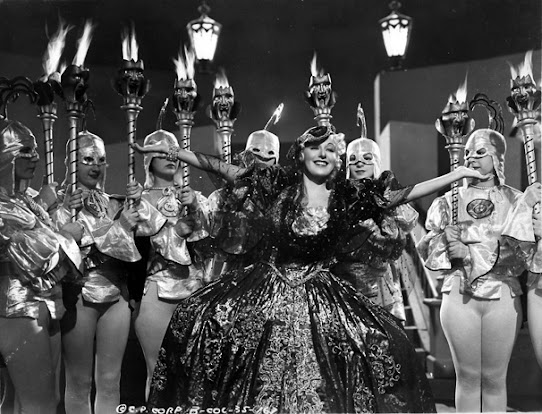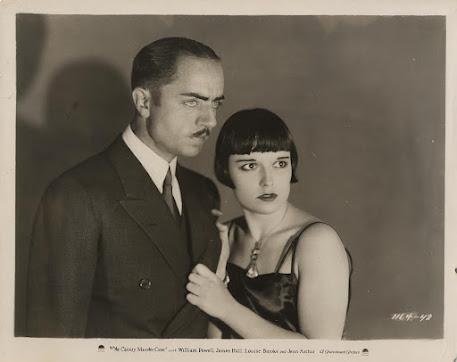It Pays to Advertise, with Louise Brooks, was released on this day in 1931. The film is a farce about rival soap companies, an advertising agency, and a ne’er do-well playboy who attempts to make good. Louise Brooks plays Thelma Temple, a dancer appearing in a musical titled Girlies Don’t Tell. More about the film can be found on the Louise Brooks Society filmography page.
Production on the film took place in and around Los Angeles in late 1930. Brooks’ part in the film, done to fulfill her contract with Paramount, amounted to little more than a cameo. The Hollywood Reporter wrote “Louise Brooks flashes in and out of the opening scenes and looks like a good bet for bigger roles.” Due to tepid reviews and negative publicity, It Pays to Advertise did poorly at the box office. At best, most exhibitors reported only fair business. In Los Angeles, according to one report, the film “set a new low.” The film also failed to do much for Brooks’ sputtering career.
It Pays to Advertise was based on a popular stage play from 1914. In 1931, reviewers commented that the story was old-fashioned – despite the fact that Paramount attempted to update its scenario through the use of new scenes, art deco sets, snappy dialogue, and a fast-moving script.
The film received few positive reviews. Photoplay wrote that it has “plenty of speed and lots of laughs”, while praising the “perfect cast”. Variety wrote “Subject to the limitation of all screen farces, this revamped stage frolic makes good enough program material with only moderate prospects at the box office.” New York’s The World, however, called it “pretty dreary.” The New Yorker stated “Among the dull pictures of the week we might list that old relic, It Pays to Advertise, which is full of smart-aleck cracks and is altogether a bore.”
The film starred Norman Foster, then husband of Claudette Colbert, and Carol Lombard, who was at the beginning of her film career. The gravel-voiced Eugene Pallette played the soap king; he had also played a supporting role in Brooks’ previous American film, The Canary Murder Case. The fast talking Skeets Gallagher played the wisecracking publicist – then called press agents. Brooks received fifth billing, and was largely left off promotional materials supplied by the studio.
Few publications mentioned Brooks, except to mention her brief appearance. Some publications noted that the role represented a comeback. The Kansas City Star commented, “Carole Lombard is pretty as the Mary Grayson in the cast, but Louise Brooks, who used to be quite a name in the photoplay world, is more attractive as the actress who does the airplane fall and is not seen thereafter.” Harry Evans, writing in Life magazine, stated “Louise Brooks, whom we have not seen on the screen since her momentary appearance in The Canary Murder Case (in which a voice double was used to speak her lines), seems to have been studying, as she gets away with her bit in this one creditably. Her real purpose in the film, however, is to show her legs, and in this phase of stage-craft she certainly needs no double.”
Under its American title, documented screenings of the film took place in Australia (including Tasmania), British Malaysia (Singapore), Canada, China, France, Hong Kong, Ireland, Jamaica, The Netherlands, New Zealand, South Africa, and the United Kingdom (including England, Northern Ireland, and Scotland). In the United States, the film was also promoted under the title Vale a Pena Anunciar (Portuguese-language press). Elsewhere, It Pays to Advertise was shown under the title To platí, aby inzeroval (Czechoslovakia).
SOME THINGS ABOUT THE FILM YOU MAY NOT KNOW:
— It Pays to Advertise was based on the play of the same name by Roi Cooper Megrue and Walter C. Hackett. It was first presented on the Broadway stage on September 8, 1914 at the Cohan Theatre, and ran for nearly a year. Thelma Temple, the character played by Louise Brooks, does not appear in the original play.
— Set in the advertising and business world, It Pays to Advertise referenced a number of actual products and their slogans. As a result, one trade journal took exception to the practice. Harrison’s Reports, which billed itself “a reviewing service free from the influence of film advertising,” objected to product placement in film — be it verbal or visual. Over the course of four months (in articles titled “The Facts About Concealed Advertisements in Paramount Pictures,” “This Paper’s Further Efforts Against ‘Sponsored’ Screen Advertisements,” and “Other Papers That Have Joined the Harrison Crusade Against Unlabelled Screen Advertising”) editor P. S. Harrison railed against the business world farce in particular and product placement in films in general. “The Paramount picture, It Pays to Advertise, is nothing but a billboard of immense size. I have not been able to count all of the nationally advertised articles that are spoken of by the characters.” In the next issue, Harrison stated “In last week’s issue the disclosure was made that in It Pays to Advertise there are more than fifteen advertisements in addition to the main advertisement, ’13 Soap Unlucky for Dirt,’ which Paramount is accused of having created as a brand for the purpose of selling it.” Taking the high moral ground, Harrison’s Reports spurred a campaign against “sponsored moving pictures – meaning pictures which contain concealed or open advertising of some one’s product.” Harrison wrote to the studios – and Harrison’s Reports noted that a handful responded with pledges to not include verbal or visual product placement. The crusading editor also wrote to more than 2,000 newspapers, and a number published articles and editorials decrying the practice. Among those papers that joined Harrison’s cause were four of the New York dailies, the Gannett chain, and scores of small town papers, as well as the Denver Post, Detroit Free Press, St. Louis Globe-Democrat, and Tulsa Tribune. The Christian Science Monitor added to the chorus of complaint when it remarked, “Paramount should have been well paid for the large slices of publicity for trade-marked products that are spread all through this artificial story.”
— The play has been made into a film on four occasions: there was a silent film in 1919, directed by Donald Crisp; the talkie in 1931, directed by Frank Tuttle; and a Swedish adaptation in 1936, directed by Anders Henrikson. In 1932, Paramount produced French language version of the 1931 film: Paramount remade the film at their studio at Joinville, France under the title Criez-le sur les toits, directed by Karl Anton and starring Saint-Granier and Robert Burnier.
THE LEGAL STUFF: The Louise Brooks Society™ blog is authored by Thomas Gladysz, Director of the Louise Brooks Society (www.pandorasbox.com). Original contents copyright © 2023. Further unauthorized use prohibited.





































